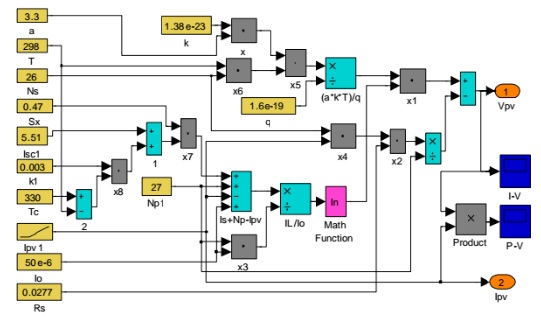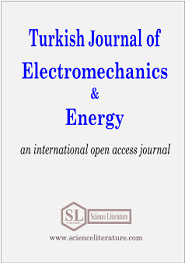
Physical Structure, Electrical Design, Mathematical Modeling and Simulation of Solar Cells and Modules
Abstract
In this study, the general physical structure, specifications and types of solar cells as well as their manufacturing processes, and mathematical model have been reviewed, in detail. This study is a complementary work to authors’ previous study which captured considerable interest in literature. Matlab/Simulink software based simulation of Photovoltaic (PV) model has been visually programmed; and current-voltage (I-V) and power-voltage (P-V) characteristics have been obtained for different number of series and parallel connected cells at different temperature values. The simulation results have been compared with theoretical results for the modeled solar cell. Results showed that the model established is quite well in agreement with the theoretical results and it is possible to apply the model to other hybrid systems. The model can also be used as a reference by solar cell manufacturers and in the experimental studies.
Full Text:
PDFReferences
A. Joyce., C. Rodrigues, R. Manso, Modeling a PV System, Renewable Energy 22, 275-280 (2001).
L. Fangrui, D. Shanxu, L. Fei, L. Bangyin, and K. Yong, A Variable Step Size INC MPPT Method for PV Systems, IEEE Transactions on Industrial Electronics, 55(7), (2008).
M.A.S. Masoum, H. Dehbonei, E.F. Fuchs, Theoretical and Experimental Analyses of Photovoltaic Systems with Voltage and Current-Based Maximum Power-Point Tracking, IEEE Transactions on Energy Conversion, 17(4), (2002).
A.D. Hansen, P. Sørenson, L.H. Hansen, H. Bindner, Models for a Stand-Alone PV System, Risø National Laboratory, Roskilde, Report, December, (2000).
M. Uzunoglu, O.C. Onar, M.S. Alam, Modeling, Control and Simulation of a PV/FC/UC Based Hybrid Power Generation System for Stand-alone Applications, Renewable Energy 34, 509-520, (2009).
G.R. Walker., P.C. Sernia., Cascaded DC-DC Converter Connection of Photovoltaic Modules, IEEE Transactions on Power Electronics, 19(4), 1130-1140, July (2004).
G. Walker, Evaluating MPPT Converter Topologies Using A Matlab PV Model, Journal of Electrical & Electronics Engineering, 21(1), 49-56,( 2001).
I.H. Altaş, A.M. Sharaf, A Photovoltaic Array Simulation Model for Matlab-Simulink GUI Environment, IEEE Conference, 341-345, (2007).
H.L. Tsai., C.S. Tu., and Y.J. Su, Development of Generalized Photovoltaic Model Using Matlab/Simulink, WCECS 2008, San Francisco, USA, October 22-24, (2008).
M.G.L. Francisco, Model of Photovoltaic Module in MATLAB, II CIBELEC Conference, (2005).
E. Lorenzo, Solar Electricity Engineering of Photovoltaic Systems, Artes Graficas Gala, S.L., Spain, (1994).
M.E. Ropp, S. Gonzales, Development of Matlab/Simulink Model of a Single- Phase Grid-Connected Photovoltaic System, IEEE Transactions on Energy Conversion, (2009).
H. Patel, V. Agarwal, MATLAB-Based Modeling to Study the Effects of Partial Shadings on PV Array Characteristics, IEEE Transactions on Energy Conversion, 23(1), 302-311, March (2008).
A.A. Hegazy, Comparative Study of the Performances of Four Photovoltaic/Thermal Solar Air Collectors, Energy Conversion& Management 41, 861-881, (2000).
T.S. Navruz, M. Sarıtaş, Efficiency Variation of The Intermediate Band Solar Cell Due to The Overlap Between Absorption Coefficients, Solar Energy Materials & Solar Cells 92, 273-282, (2008).
M.E. Sahin, H.İ. Okumus, A Fuzzy Logic Controlled PV-Powered Buck–Boost DC-DC Converter for Battery-Load System, In the Proceedings of INISTA International Conference, Jule 2-4th, Trabzon, TURKEY, 325-349, (2012)
A.M. Sharaf, M.E. Sahin, A Novel Photovoltaic PV-Powered Battery Charging Scheme for Electric Vehicles, ICEAS IEEE Conference, India, (2011).
M.E. Şahin, H.İ. Okumuş, Modelling and Simulation of Solar Cell Module in Matlab/Simulink, The Journal of Electrical, Electronics, Computer and Biomedical Engineering 3(5), 17-25, (2013).
K. Bücher, G. Kleiss, D. Bätzner, Photovoltaic Modules in Buildings: Performance and Safety, Renewable Energy 15, 545-551, (1998).
A. Manallah, M. Bouafia, A. Guechi, Photometric Study of a Solar Cell Panel Si-c, NuRER Conference, İstanbul, (2012).
National Aeronautics and Space Administration, Science Mission Directorate, Visible Light. Retrieved February 06, 2016, from Mission: Science website: http://missionscience.nasa.gov/ems/09_visiblelight.html, (2010).
A.S. Joshi, I, Dinçer, B.V. Reddy, Performance Analyses of Photovoltaic Systems: A Review, Renewable and Sustainable Energy Reviews 13, 1884–1897, (2009).
M.E. Şahin, ‘Design and Control of Parallel Connected Buck-Boost Converter for Hybrid Energy System, Ph.D. Dissertation, Karadeniz Technical University, Turkey, (2014).
J. Ventre, Photovoltaic Systems Engineering, Taylor & Francis, Second Edition, (2004).
Converting Sunlight into Electricity, Kyocera Corporation, retrieved from Kyocera website:http://global.kyocera.com/solarexpo/solar_power/mechanism.html, Last Access Date: February 06th, 2016.
M. Augustin, L. Castaner and T. Markvart. Solar cells: materials, manufacture and operation, Academic Press, (2012).
S. Tatsuo, Advances in crystalline silicon solar cell technology for industrial mass production, NPG Asia Materials 2.3, 96-102, (2010).
J. Czochralski, A new method for the measurement of the crystallization rate of metals, Zeitschrift für Physikalische Chemie, 92, 219–221, (1918).
P. W. Bridgman, Certain Physical Properties of Single Crystals of Tungsten, Antimony, Bismuth, Tellurium, Cadmium, Zinc, and Tin scheme, Proceedings of the American Academy of Arts and Sciences, 60(6), 305–383, (1925).
S. Martinuzzi, and at all., Silicon Solar Cells, Crystalline, Encyclopedia of Sustainability Science and Technology, Springer New York, 9196-9240, (2012).
M. Roger, and A. Abtahi, Photovoltaic systems engineering. CRC press, (2010).
M. Keiichiro, et al., Achievement of more than 25% conversion efficiency with crystalline silicon heterojunction solar cell, Photovoltaics, IEEE Journal of 4.6, 1433-1435, (2014).
M.A. Green, et al., Solar cell efficiency tables (Version 45), Progress in photovoltaics: research and applications 23.1, 1-9, (2015).
D.L. Block, Production of hydrogen by photovoltaic-powered electrolysis. Task 1 report. No. DOE/AL/85802--T2-Pt. 1; FSEC-CR--857-95-Pt. 1. Florida Solar Energy Center, Cocoa, FL (United States), (1995).
URN: https://sloi.org/urn:sl:tjoee1113
Copyright (c) 2016 Turkish Journal of Electromechanics and Energy

This work is licensed under a Creative Commons Attribution-NonCommercial 4.0 International License.

 Indexed in:
Indexed in:
















